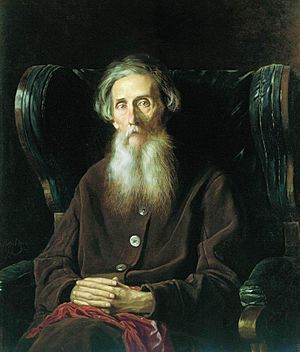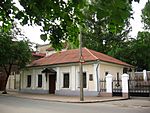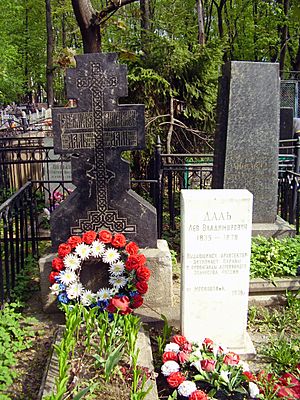Vladimir Dal facts for kids
Quick facts for kids
Vladimir Dal
|
|
|---|---|
| Владимир Даль | |
 |
|
| Born | November 22, 1801 Lugansk Factory, Yekaterinoslav Vice-Royalty, Russian Empire
|
| Died | October 4, 1872 (aged 70) Moscow, Russian Empire
|
| Resting place | Vagankovo Cemetery, Moscow |
| Known for | Explanatory Dictionary of the Living Great Russian Language |
| Scientific career | |
| Fields | Lexicography |
Vladimir Ivanovich Dal (Russian: Влади́мир Ива́нович Даль; November 22, 1801 – October 4, 1872) was a very important Russian expert. He was famous for making dictionaries. He also knew many languages and studied the Turkic people. Vladimir Dal helped start the Russian Geographical Society. During his life, he wrote down many stories and sayings from people. These became part of Russian folklore. His most famous work is the Explanatory Dictionary of the Living Great Russian Language.
Early life and adventures
Vladimir Dal's father, Johan Christian von Dahl, was a doctor from Denmark. He knew many languages like German, English, French, and Russian. His mother, Julia Adelaide Freytag, had German and French family roots. She also spoke at least five languages. Her family was known for being scholars.
Vladimir Dal was born in a town called Lugansky Zavod. This place is now Luhansk, in Ukraine. It was part of the Russian Empire back then. In the late 1700s, many different groups of people lived in this area. These included Ukrainians, Greeks, and Tatars. Dal grew up learning about these different cultures and languages.
Dal joined the Imperial Russian Navy in 1814. He finished his studies at the Saint Petersburg Naval Cadet School in 1819. In 1826, he started studying medicine at Dorpat University. He worked as a military doctor in a war against Turkey. He also helped in a campaign against Poland. Later, he left the military hospital. He then worked for the government in different places. He even joined a military trip to Khiva.
From a young age, Dal loved language and folk stories. He walked through the countryside, collecting sayings and fairy tales. He wrote down stories in different Slavic languages. In 1832, he published his first collection of fairy tales. His friend, the famous poet Alexander Pushkin, even turned some of Dal's unpublished tales into poems. When Pushkin was dying in 1837, Dal was there to care for him. In 1838, Dal became a member of the Russian Academy of Sciences.
Making dictionaries
In the years that followed, Dal used the pen name Kazak Lugansky. This means "Cossack from Luhansk." He wrote many realistic stories. He kept working on his language studies. He also traveled a lot during the 1850s and 1860s. He didn't have time to edit all his fairy tales. So, he asked Alexander Afanasyev to prepare them for publishing.
Dal's biggest work was his Explanatory Dictionary of the Living Great Russian Language. This huge dictionary was published in four large books between 1863 and 1866. It explained thousands of Russian words. A few years later, he published The Sayings and Bywords of the Russian people. This book had more than 30,000 sayings. Both of these books have been printed many, many times.
Dal believed in using native Russian words instead of foreign ones. His dictionary became very important for Russian writers in the early 1900s. Writers like Maximilian Voloshin said that reading Dal's dictionary was like learning a new language. It showed them the rich treasure of Russian words.
Famous writers like Vladimir Nabokov and Aleksandr Solzhenitsyn loved Dal's dictionary. Nabokov read it every evening. Solzhenitsyn took a volume of it with him to a prison camp. Dal's dictionary is still important today. It helps us understand old Russian words that are no longer used. It also helped create the most complete dictionary of Slavic words.
For his amazing dictionary, Dal received the Lomonosov Medal. He also got the Constantine Medal in 1863. He became an honorary member of the Russian Academy of Sciences.
He is buried in the Vagankovo Cemetery in Moscow. In 2000, UNESCO called it "The International Year of Vladimir Dal." This was to celebrate 200 years since his birth.
His lasting impact
- In 1986, a museum opened in Moscow, Russia, to honor Dal.
- In Luhansk, Ukraine, Dal's home became a Literary Museum. They collected many of his original books there.
- In 2001, a university in Luhansk, Ukraine, was named after him. It is called the East Ukrainian Volodymyr Dahl National University.
- In 2017, the State Literary Museum in Moscow, Russia, was officially renamed after V. I. Dal.
- On November 22, 2017, Google celebrated his 216th birthday with a special Google Doodle.
See also
 In Spanish: Vladímir Dal para niños
In Spanish: Vladímir Dal para niños



